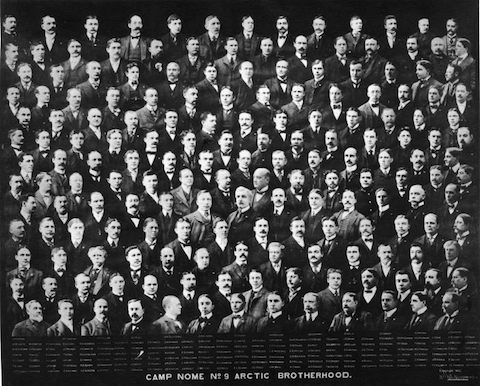
For those of us born after the invention of pencilin—presumably anyone and everyone who has ever checked into Microkhan’s universe—it’s difficult to fathom the esteem in which fraternal organizations were once regarded. Thumb through any society page from the first half of the 20th century and you’ll doubtless encounter one article after another about the estoerica of Kiwanis or Roatarian politics—the fierce squabbles over leadership positions, the spats over the right date on which to hold the annual potluck. In the era before cheap travel and mass communication enabled businessmen to strike deals with people who lived beyond their county’s borders, the ties created by fraternal bonds were integral to making commerce happen—and, one suspects, to giving men an outlet for energies that are currently expended on professional football and Internet pornography.
It makes perfect sense, then, that Alaska’s early white settlers transported the fraternal-organization concept to their new homes. The foremost of the resulting clubs was the Alaskan Brotherhood, founded in 1899, which managed to garner over 10,000 members before it disintegrated in the late 1920s. Because of the lack of leisure options in the frozen north, the organization was fond of staging shows—some of admirable quality, others that were appallingly racist.
The Arctic Brotherhood may have lasted until the dawn of the Great Depression, but its heyday was brief—everything went downhill after 1909, when a schism occurred over the question of whether residents of the Lower 48 could be allowed to join, even on a ceremonial basis. The Dawson Daily News covered the controversy:
Considerable agitation is evidencing itself in the local Arctic Brotherhood circles over the news that Bill Taft is to be initiated down in Seattle along with about 200 others who are trying to climb in the band wagon when the president rides the goat, and there threatens to be a mighty upheaval is this desecration of the brotherhood’s ideals is really pulled off.
There are shades here, of course, of controversies of more recent vintage, concerning some radical Alaskans’ antipathy toward those scoundrels in the Lower 48.
Much more Arctic Brotherhood history on the site of its modern incarnation.
(Image via Alaska’s Digital Archives)


Captain Button // Sep 6, 2011 at 4:23 pm
Not quite what you are talking about here, but I’ve wondered if the Citizens’ Band (CB) radio craze in the 1970s counts as social media.
Brendan I. Koerner // Sep 6, 2011 at 6:12 pm
@Captain Button: Good point. And if you stretch back even further, how about the popularity of party lines in the first half of the twentieth century? There’s something undeniably attractive about the idea of having a public conversation, even if you don’t acknowledge that others are listening in.
Captain Button // Sep 9, 2011 at 6:47 pm
Had you seen the “Dead Media Project”? I recall seeing a bunch of stuff on their website years ago about things like the camera obscura and some super long mural of the Battle of Gettysburg or something like that. The website seems to be down but here’s the Wikipedia page:
http://en.wikipedia.org/wiki/Dead_Media_Project